EcoCAR: The Next Challenge
Background
EcoCAR: The NeXt Challenge was a three-year collegiate advanced vehicle technology engineering competition established by the United States Department of Energy (DOE) and General Motors (GM), and was managed by Argonne National Laboratory.
The competition challenged 16 universities across North America to reduce the environmental impact of a Saturn Vue by minimizing the vehicle’s fuel consumption and reducing its emissions while retaining the vehicle’s performance, safety and consumer appeal.
Students used a real-world engineering process to design and integrate their advanced technology solutions into a GM-donated vehicle. Students designed and built advanced propulsion solutions based on vehicle categories from the California Air Resources Board (CARB) zero emissions vehicle (ZEV) regulations. They explored a variety of cutting-edge clean vehicle solutions, including full-function electric, range-extended electric, hybrid, plug-in hybrid and fuel cell technologies. In addition, students incorporated lightweight materials into the vehicles, improved aerodynamics, and utilized alternative fuels such as ethanol, biodiesel and hydrogen.
Teams followed a real-world approach modeled after GM’s global vehicle development process (GVDP), which gave students valuable experience in real-world engineering practices, resource allocation and meeting deliverables. While previous student engineering competitions focused primarily on hardware modifications, EcoCAR included a unique focus on modeling and simulation, as well as subsystem development and testing.
In the first year of EcoCAR (2008-2009), participating teams used math-based design tools—such as Argonne’s Powertrain Systems Analysis toolkit (PSAT) or similar vehicle models research—to compare and select an advanced vehicle powertrain that meets the goals of the competition. Teams used software to ensure that their chosen components fit into their vehicle and that the electrical, mechanical and software systems functioned properly. Teams also used software-in-the-loop (SIL) and hardware-in-the-loop (HIL) to better develop controls and subsystems. During the Year One competition, the teams traveled to Toronto, Canada to participate in the year-end event which featured several static presentations and a trade show display.
During the second year of EcoCAR (2009-2010), teams had to translate their design into reality by developing a ‘mule’ vehicle. By the end of the academic year, the student vehicles had to be 65% complete. General Motors hosted the teams at their Desert Proving Grounds in Yuma, Arizona for all dynamic vehicle events, including accelerating and braking, emissions and energy consumption, dynamic consumer acceptability, AVL DRIVE Quality, autocross, and more. Teams then headed to San Diego, California for several other events and the awards ceremony.
In the third and final year (2010-2011), EcoCAR teams had to refine their existing student powertrain vehicles into a 99% showroom-ready vehicle. The students vehicles were heavily tested at General Motors Milford Proving Grounds in Milford, Michigan before heading to Washington, D.C. for a ride and drive event.
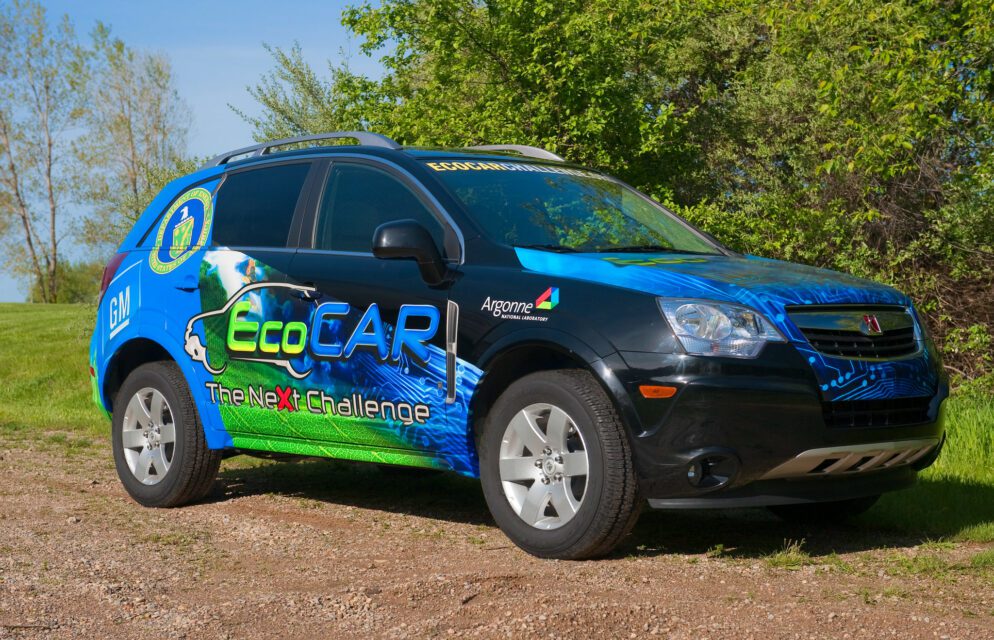
EcoCAR: The Next Challenge
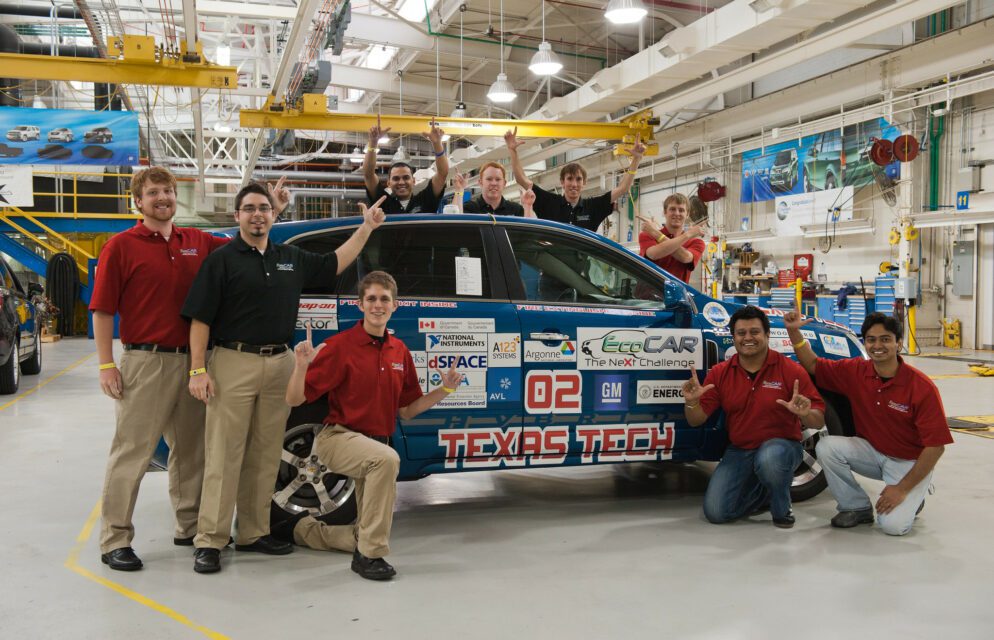
EcoCAR: The Next Challenge
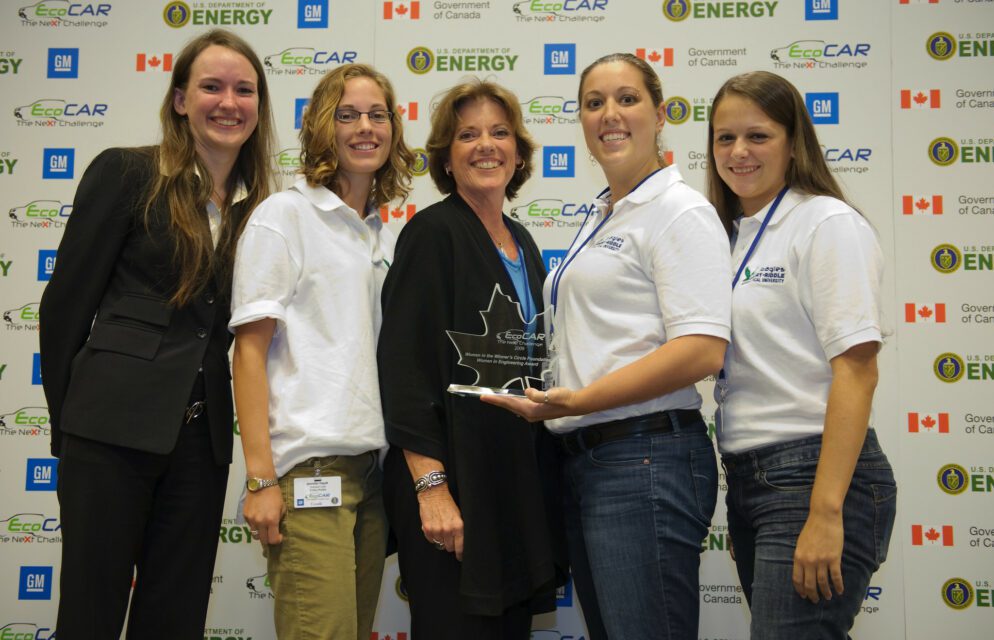
EcoCAR: The Next Challenge
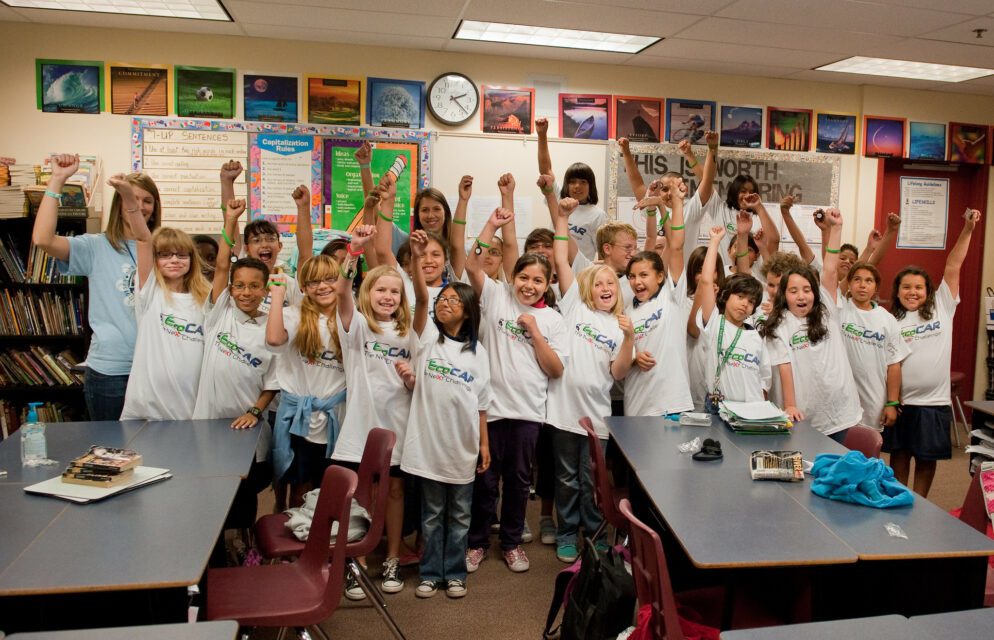
EcoCAR: The Next Challenge
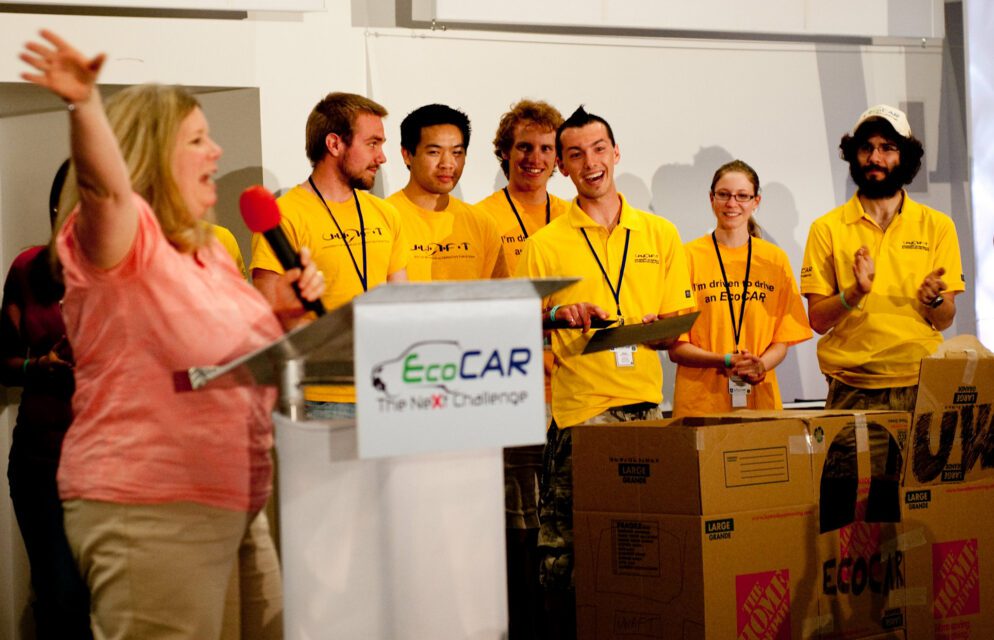
EcoCAR: The Next Challenge
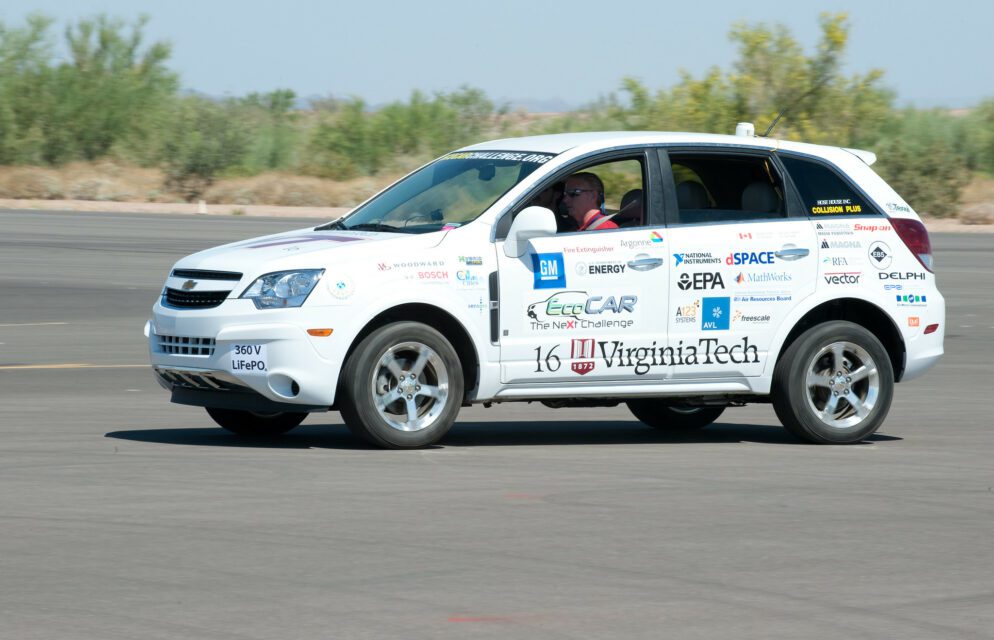
EcoCAR: The Next Challenge
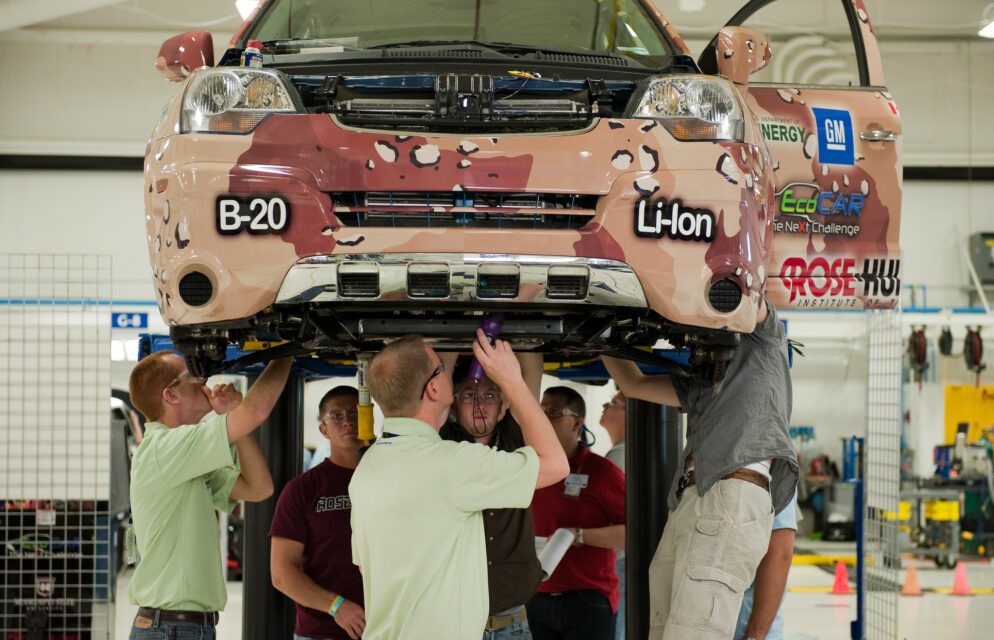
EcoCAR: The Next Challenge
Innovations & Highlights
Over the course of three years, EcoCAR teams had to reduce the environmental impact of a Saturn Vue by minimizing the vehicle’s fuel consumption and reducing its emissions while retaining the vehicle’s performance, safety and consumer appeal.
Teams had to meet the competition’s technical goals, which included incorporating technologies that reduced petroleum energy consumption on the basis of a total fuel cycle well-to-wheel (WTW) analysis, increase vehicle energy efficiency, reduce criteria and well-to-wheel greenhouse gas (GHG) and criteria emissions, and maintain consumer acceptability in the areas of performance, utility and safety.
- EcoCAR: The NeXt Challenge marked the first time a controller hardware-in-the loop activity was introduced into an academic setting, providing teams the opportunity to test control software before driving the vehicle
- All competition vehicles featured some plug-in capability.
- The competition marked the first time in AVTCs where teams designed their own energy storage systems, using lithium ion prismatic cell technology
- Teams used tools such as Powertrain Systems and Analysis Toolkit (PAST) to help define their vehicle technical specifications and architectures what would satisfy those spec’s
- Mississippi State University achieved 118 MPGGE (miles per gallon of gasoline equivalent)
- on the EcoCAR Cycle in Year Two
- EcoCAR teams followed industry-standard design practices such as DFMEA and fault tree analysis to develop their control systems
- Ohio State University built powertrain controllers from the ground up in an impressive and industrial-grade display of Model-Based Design with automatic code generation.
- In Year Three, Virginia Tech was able to increase fuel economy over 70% above the stock vehicle to 81.9 MPGGE while demonstrating the lowest tailpipe emissions (Tier 2 bin 2) amongst all teams with combustion engines
- University of Ontario Institute of Technology built a custom designed Li+ pack based on Kokam technology
- In Year Three, two hydrogen fuel cell vehicles placed in the top 6 overall – an AVTC first!
- During Year One, teams had to produce a trade show display that highlighted and featured powertrain components
- The program offered fellowships to communication students provided by Clean Cities – a first in AVTC history!
- The University of Waterloo developed a carbon fiber hood for their vehicle in Year Three
- In Year Three, the University of Victoria had a 0-60 MPH acceleration time of 6.35 seconds!
- EcoCAR introduced emissions and energy consumption events very similar to real-world plug-in hybrid vehicle testing that used SAE J2841 and J1711 standards to utility factor-weight electricity consumption in vehicles that do and do not have charge depleting ranges
- Teams utilized Rapid Control Prototyping Systems to develop advanced controller and communication based models of production vehicle
- Ohio State University developed and deployed a dual clutch automated manual transmission in their E85 PHEV
Universities Involved
Winners & Awards
Each year, university teams compete in a variety of static and dynamic events that range from oral presentations to on-road vehicle testing to communications and business tactics. These static and dynamic events are judged by industry sponsors and professionals, both throughout the year and in-person at the year-end competition. Below includes more detail about event awards and winners:
Year One 2008-2009
- 1st Place Overall – Ohio State University
- 2nd Place Overall – University of Victoria
- 3rd Place Overall – Mississippi State University
- 4th Place Overall – Embry-Riddle Aeronautical University
- 5th Place Overall – University of Waterloo
- 6th Place Overall – Virginia Tech
- Best Written Design Report – Ohio State University
- Best Technical Reports, 1st Place – University of Victoria
- Best Technical Reports, 2nd Place – Embry-Riddle Aeronautical University
- Best Technical Reports, 3rd Place – Mississippi State University
- Best Overall Safety Award – Embry-Riddle Aeronautical University
- HIL Evaluation Event, 1st Place – Ohio State University
- HIL Evaluation Event, 2nd Place – University of Victoria
- HIL Evaluation Event, 3rd Place – University of Waterloo
- Mechanical Systems Presentation – Mississippi State University
- Controls Event Presentation – Ohio State University
- Project Initiation Approval Presentation – Embry-Riddle Aeronautical University
- Electrical Systems Presentation – University of Victoria
- Best Trade Show Display and Presentation – Ohio State University
- Best Overall Business Program – Ohio State University
- Outstanding Outreach, 1st Place – Ohio State University
- Outstanding Outreach, 2nd Place – Mississippi State University
- Outstanding Outreach, 3rd Place – Pennsylvania State University
- Best Social Networking – Pennsylvania State University
- Best Communications Plan – Ohio State University
- Best Media Relations Program – University of Victoria
- Best Website – Rose-Hulman Institute of Technology
- Best Education Program – Texas Tech University
- Best Technical Success Story – Ohio State University
- Spirit of Outreach – Embry-Riddle Aeronautical University
- Creation Promotion of EcoCAR – Mississippi State University
- Ron Stence Spirit of the Challenge – North Carolina State University
- Dr. Donald Streit Sportsmanship Award – Pennsylvania State University
- Team to Watch Award – West Virginia University
- National Instruments Most Innovative Use of Graphical Design Award, 1st Place – Embry-Riddle Aeronautical University
- National Instruments Most Innovative Use of Graphical Design Award, 2nd Place – Rose-Hulman Institute of Technology
- National Instruments Most Innovative Use of Graphical Design Award, 3rd Place – Georgia Tech
- Freescale Silicon on the Move Award, 1st Place – University of Wisconsin – Madison
- Freescale Silicon on the Move Award, 2nd Place – Georgia Tech
- Freescale Silicon on the Move Award, 3rd Place – Ohio State University
- The MathWorks Modeling Award, 1st Place – University of Victoria
- The MathWorks Modeling Award, 2nd Place – Rose-Hulman Institute of Technology
- The MathWorks Modeling Award, 3rd Place – University of Waterloo
- dSPACE Embedded Success Award, 1st Place – Ohio State University
- dSPACE Embedded Success Award, 2nd Place – University of Waterloo
- dSPACE Embedded Success Award, 3rd Place – University of Victoria
- National Science Foundation Outstanding Long–Term Faculty Award – Dr. Doug Nelson, Virginia Tech
- National Science Foundation Outstanding Incoming Faculty Advisor Award – Dr. Darris White, Embry-Riddle Aeronautical University
- Women in the Winner’s Circle Foundation, Rookie of the Year Award – Samantha Hazell, University of Ontario Institute of Technology
- Women in the Winner’s Circle Foundation, Women in Engineering Award – Nicole Lambiase, Jeanette Barott, Jennifer Haytt, Nikki Puschacz, Embry-Riddle Aeronautical University
Year Two 2009-2010
- 1st Place Overall – Mississippi State University
- 2nd Place Overall – Virginia Tech
- 3rd Place Overall – Pennsylvania State University
- 4th Place Overall – University of Victoria
- 5th Place Overall – Ohio State University
- 6th Place Overall – University of Ontario Institute of Technology
- Overall Safety Award – Virginia Tech
- Best Technical Report (tie) – Pennsylvania State University and University of Victoria
- HIL Evaluation Event, 1st Place – Ohio State University
- HIL Evaluation Event, 2nd Place– Virginia Tech
- HIL Evaluation Event, 3rd Place – Mississippi State University
- Mechanical Systems Presentation – Mississippi State University
- Electrical Systems Presentation – Virginia Tech
- Controls Event Presentation – Mississippi State University
- Vehicle Design Review – Mississippi State University
- Static Consumer Acceptability – Virginia Tech
- Dynamic Consumer Acceptability – Ohio State University
- Best Lane Change (tie) – Pennsylvania State University and University of Ontario Institute of Technology
- Best 0-60 MPH Acceleration – Mississippi State University
- AVL DRIVE Quality Award – Pennsylvania State University
- Best 60-0 MPH Braking – Virginia Tech
- Best Autocross – Mississippi State University
- Lowest Fuel Consumption – Mississippi State University
- Lowest Fuel Consumption Runner Up – Pennsylvania State University
- Lowest Tailpipe Emissions – Mississippi State University
- Lowest Tailpipe Emissions Runner Up (tie) – Virginia Tech and Pennsylvania State University
- Lowest Well-to-Wheel Greenhouse Gas – Mississippi State University
- Lowest Well-to-Wheel Greenhouse Gas Runner Up – Pennsylvania State University
- Lowest Petroleum Energy Usage – Mississippi State University
- Lowest Petroleum Energy Usage Runner Up – Virginia Tech
- Outreach Program, 1st Place – Mississippi State University
- Outreach Program, 2nd Place – Ohio State University
- Outreach Program, 3rd Place – Pennsylvania State University
- Best Team Website Presentation – Mississippi State University
- Best Final Outreach Presentation – Mississippi State University
- Best Sponsor Success Story – Ohio State University
- Best Social Media Program – Mississippi State University
- Best Media Relations Program – Mississippi State University
- Best Education Program – Mississippi State University
- Creative Promotion of EcoCAR Mississippi State University
- Spirit of Outreach Award – University of Victoria
- Best Collaboration with a Clean Cities Coalition – Ohio State University
- Most Improved Team – North Carolina State University
- Best Vehicle Appearance – Rose-Hulman Institute of Technology
- Best Engineering & Fabrication Workmanship – University of Waterloo
- Ron Stence Spirit of the Challenge Award – University of Victoria
- Dr. Donald Streit Sportsmanship Award – University of Victoria
- National Instruments Most Innovative Use of Graphical Design Award, 1st Place – Virginia Tech
- National Instruments Most Innovative Use of Graphical Design Award, 2nd Place – University of Wisconsin-Madison
- National Instruments Most Innovative Use of Graphical Design Award, 3rd Place – Embry-Riddle Aeronautical University
- Freescale Silicon on the Move Award – Ohio State University
- The MathWorks Modeling Award, 1st Place – Ohio State University
- The MathWorks Modeling Award, 2nd Place – Rose-Hulman Institute of Technology
- The MathWorks Modeling Award, 3rd Place – Mississippi State University
- dSPACE Embedded Success Award, 1st Place – Ohio State University
- dSPACE Embedded Success Award, 2nd Place – Mississippi State University
- dSPACE Embedded Success Award, 3rd Place – University of Victoria
- A123 Systems Award, 1st Place – Mississippi State University
- A123 Systems Award, 2nd Place – Pennsylvania State University
- A123 Systems Award, 3rd Place – University of Victoria
- National Science Foundation Outstanding Long–Term Faculty Award – Dr. Roydon Fraser, University of Waterloo
- National Science Foundation Outstanding Incoming Faculty Advisor Award – Dr. Zuomin Dong and Dr. Curran Crawford, University of Victoria
- Women in the Winner’s Circle Foundation, Rookie of the Year Award – Michigan Technological University
- Women in the Winner’s Circle Foundation, Women in Engineering Award – Beth Bezaire, Ohio State University
Year Three 2010-2011
- 1st Place Overall – Virginia Tech
- 2nd Place Overall – Ohio State University
- 3rd Place Overall – University of Waterloo
- 4th Place Overall – Pennsylvania State University
- 5th Place Overall – Missouri University of Science and Technology
- 6th Place Overall – Mississippi State University
- Best Lange Change – West Virginia University
- Shortest 60-0 MPH Braking Distance – Virginia Tech
- Fastest High Speed Passby Maneuver –Mississippi State University
- Best Autocross Time – Pennsylvania State University
- Best Autocross “Fun Run” Time – Patrick Walsh, Virginia Tech
- Fastest Acceleration 0-60 MPH – University of Victoria
- Fastest Acceleration 50-70 MPH – University of Victoria
- Best AVL Drive Quality (tie): Pennsylvania State University and Virginia Tech
- Best Static Consumer Acceptability – Mississippi State University
- Best Vehicle Testing Complete Presentation – Virginia Tech
- Best Dynamic Consumer Acceptability – Virginia Tech
- Best Technical Presentation – Mississippi State University
- Best Controls Presentation – The Ohio State University
- Lowest Fuel Consumption – Virginia Tech
- Lowest Fuel Consumption Runner Up – Pennsylvania State University
- Lowest Petroleum Energy Use – Missouri University of Science and Technology
- Lowest Petroleum Energy Use Runner Up – Virginia Tech
- Lowest Well to Wheel Greenhouse Gas Emissions – Penn State
- Well to Wheel Greenhouse Gas Emissions Runner Up – Missouri University of Science and Technology
- Lowest Tailpipe Emissions – Missouri University of Science and Technology
- Lowest Tailpipe Emissions Runner Up – Virginia Tech
- Overall Outreach, 1st Place – University of Waterloo
- Overall Outreach 2nd Place – Ohio State University
- Overall Outreach, 3rd Place – Mississippi State University
- Best Collaboration with a Clean Cities Coalition – Ohio State University
- Best Collaboration with a Clean Cities Coalition, Special Recognition – Rose-Hulman Institute of Technology
- Best Website – University of Victoria
- Best Sponsor Success Story – University of Waterloo
- Best Social Media Program – Ohio State University
- Best Creative Promotion of EcoCAR – Mississippi State University
- Spirit of Outreach – Penn State
- Best Media Relations Program – University of Waterloo
- Best Consumer Campaign – University of Waterloo
- Best Influencer Campaign – Mississippi State University
- Best Outreach Presenter – Rachel Dobroth, Virginia Tech
- Best Final Outreach Presentation – University of Waterloo
- Dr. Donald Streit Sportsmanship Award – Mississippi State University
- Most Improved Team – Missouri University of Science and Technology
- Ron Stence Spirit of the Challenge Award – Embry-Riddle Aeronautical University
- Editor’s Pick Award – Pennsylvania State University
- Best Vehicle Appearance – Georgia Tech
- Best Engineering Fabrication & Workmanship – University of Victoria
- National Instruments Most Innovative Use of Graphical Design Award, 1st Place – Virginia Tech
- National Instruments Most Innovative Use of Graphical Design Award, 2nd Place – Rose-Hulman Institute of Technology
- National Instruments Most Innovative Use of Graphical Design Award, 3rd Place – Embry-Riddle Aeronautical University
- Freescale Innovation Award – Ohio State University
- The MathWorks Modeling Award, 1st Place – University of Victoria
- The MathWorks Modeling Award, 2nd Place – Ohio State University
- The MathWorks Modeling Award, 3rd Place – Mississippi State University
- dSPACE Embedded Success Award, 1st Place – University of Victoria
- dSPACE Embedded Success Award, 2nd Place – Ohio State University
- dSPACE Embedded Success Award, 3rd Place – Texas Tech University
- A123 Systems Battery Workmanship Award, 1st Place – Mississippi State University
- A123 Systems Battery Workmanship Award, 2nd Place – Virginia Tech
- A123 Systems Battery Workmanship Award, 3rd Place – University of Victoria
- National Science Foundation Outstanding Long–Term Faculty Award – Dr. Marshall Molen, Mississippi State University
- National Science Foundation Outstanding Incoming Faculty Advisor Award – Dr. Shawn Midlam-Mohler, Ohio State University
- Women in the Winner’s Circle Foundation, Rookie of the Year Award – Katerina Pecinsovsky, Virginia Tech
- Women in the Winner’s Circle Foundation, Women in Engineering Award – Katherine Bovee, Ohio State University
Sponsors
EcoCAR The Next Challenge Media Coverage
Select a tab above to view content
- U.S. Department of Energy and General Motors Announce EcoCAR – December 6, 2007
- Hybrid Convoy Bound for Inauguration to Stop at Penn State – Jan 2009
- EcoCAR Teams Announce Vehicle Architecture – February 3, 2009
- EcoCAR Launches Green Garage – February 3, 2009
- Major Sponsor Join EcoCAR Challenge
- Rose Students Offer Insight into Effort to Improve Hybrids – Apr 2009
- Americans Inspired By Green Innovation – Apr 2009
- Advanced Engineering Tools Guide Student Teams to Develop ‘Green’ Cars of the Future – May 2009
- The Ohio State University Takes First Place At 2009 EcoCAR Competition – June 2009
- Toronto Sun – Green Machine – June 2009
- Snap-on Partners with EcoCAR Challenge – Oct 2009
- Letting Innovation Loose: Trucks at Work Blog – Oct 2009
- VIDEO: NC State Students Take on EcoCAR Challenge – Nov 2009
- EcoCAR Teams Gather at the Daytona International Speedway and Embry-Riddle Aeronautical University for Winter Workshop – January 2010
- Wired.com Profiles Virginia Tech EcoCAR Team – April 2010
- 2010 Local Media Yuma Advisory
- Mississippi State University Wins Top Honors in Year Two of EcoCAR Competition – May 27, 2010
- Forbes: Harnessing Youth To Build EcoCars – May 2010
- San Diego Union Tribune: Engineering Teams Graded on Fuel Efficiency – May 2010
- MotorTrend: Biodiesel Extended-range Hybrid SUV is Winner of GM’s EcoCAR Competition – May 2010
- NextGenLog: EcoCAR Winners in – Mississippi Wins Again! – May 2010
- EcoCAR 2010 Finals Coverage Book
- Mississippi State Reaches 100. And We’re Not Talking MPH. – June 2010
- GM’s New EV Hiring Tactic: Sponsor College Competitions, Skim Off the Winners- June 2010
- CNET: Peeking Under the Hood at the EcoCAR Challenge – June 2010
- VIDEO: EcoCAR Featured on MotorWeek – July 2010
- EcoCAR Teams Experience Dynamometer Testing at the Spring Workshop – March 2011
- 2011 EPA Workshop – Detroit Auto Scene
- 2011 EPA Workshop – Detroit Auto Scene EcoCAR Coverage
- Virginia Tech Wins EcoCAR Competition With An Extended-Range Electric Vehicle – June 17, 2011
- Behind the wheel at the EcoCAR college engineer competition – June 2011
- Virginia Tech’s 82 mpg car wins GM/U.S. EcoCAR challenge – June 2011
- GM Scouts For Talent At EcoCAR Competition – June 2011
- EcoCar Students Spread the Word – June 2011
- Levels of Modeling a Hybrid-Electric Vehicle: Simulation, SIL, Real-Time, and HIL – April 12, 2010
- Design, Modeling and Hardware Implementation of a Next Generation Extended Range Electric Vehicle – April 12, 2010
- Road to Lab to Math: A Student-Designed B20 Power-Split Extended Range Electric Vehicle for the EcoCAR Challenge – May 5, 2010
- EcoCAR Technology Transfer: From the Competition to the Classroom – April 12, 2011
- Model Based Engine Control Development and Hardware-in-the-Loop Testing for the EcoCAR Advanced Vehicle Competition – April 12, 2011
- An Extended-Range Electric Vehicle Control Strategy for Reducing Petroleum Energy Use and Well-to-Wheel Greenhouse Gas Emissions – April 12, 2011
- Addressing Drivability in an Extended Range Electric Vehicle Running an Equivalent Consumption Minimization Strategy (ECMS) – April 12, 2011
- Performance Study and Comparison of Representative e-CVT Based Hybrid Powertrains – April 12, 2011
- Development and Validation of an E85 Split Parallel E-REV – April 12, 2011
- Well-To-Wheel Energy Use and Greenhouse Gas Emissions Analysis of Hypothetical Fleet of Electrified Vehicles in Canada and the U.S. – April 12, 2012
- Control and Testing of a 2-Mode Front-Wheel-Drive Hybrid-Electric Vehicle – April 16, 2012
- EcoCAR Technology Transfer: From the Competition to the Classroom – April 16, 2012
- Modeling and Development of E85 Fueled Two-Mode Hybrid Electric Vehicle – April 8, 2013
































